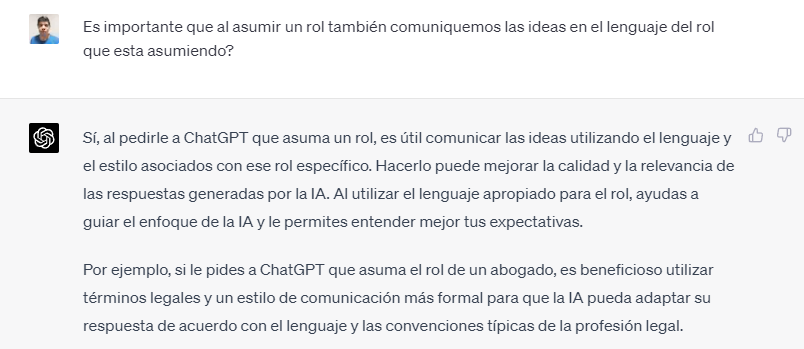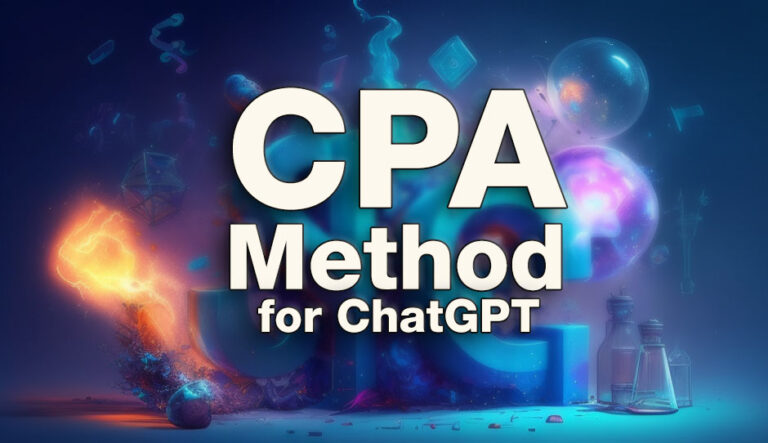A few days ago, I shared on LinkedIn what, in my opinion, is one of the best methods for creating effective prompts with GPT-4 and ChatGPT. I called it the CPA method (Context, Prompt, Adjust), and in this article, I will explain in detail what it entails and how you can leverage it to maximize its benefits.
I will also provide some examples to demonstrate its effectiveness. Are you a long-time user of ChatGPT but feel like it doesn’t give you the precise and coherent answers you expected? Do you end up frustrated by receiving unclear or irrelevant responses? If so, in this article, we will delve into the art of formulating effective questions and prompts that unlock the true potential of ChatGPT.
But before we dive into these practical tips, how about if I share a secret with you? There is a key ingredient that can make all the difference between obtaining valuable answers or total nonsense. Keep reading, and not only will you discover how to master the creation of effective prompts, but we will also unveil that secret that will enable you to make the most of artificial intelligence technology in your conversations.
What is an Effective Prompt?
An effective prompt is a clear and concise query or instruction that requests an accurate, relevant, and coherent response from an artificial intelligence language model, such as ChatGPT. An effective prompt not only helps gather useful information but also maximizes the quality of the model’s generated responses. To ensure an optimal prompt, it should incorporate the following elements:
- Context: Fundamental for success. Sufficient context in the query is essential to avoid unexpected or irrelevant outcomes. The context enables the model to better understand the situation and respond appropriately.
- Structure: When requesting lengthy or complex text, employing proper grammatical and logical structure becomes crucial. This facilitates comprehension of the query and substantially improves the results.
- Clarity: Formulating the question clearly and specifically is vital, avoiding ambiguities or vagueness that may confuse the model.
- Brevity: Keeping the query concise and to the point, excluding unnecessary or redundant information.
- Precision: Being precise by specifying relevant details that can guide the model towards generating an accurate response.
While these elements may seem contradictory to what is commonly observed on social media, where prompts tend to be lengthy, we have found that concise and precise prompts can yield equally, if not better, results. Let’s explore this further.
The Importance of Context and the Role of the CPA Method
To achieve optimal results with ChatGPT, it’s crucial to provide or generate a clear and specific context. The CPA method, which stands for Context + Prompt + Adjustments, offers an effective approach to working with ChatGPT. It’s a methodology that I have personally developed and has consistently yielded excellent results, especially in creating evergreen content. The CPA method consists of three fundamental steps: Providing or Generating the CONTEXT, crafting the PROMPT, and requesting any necessary ADJUSTMENTS. Let’s dive into each step in detail.
1) Providing or Generating the CONTEXT
The first step before making any request is to establish the context since ChatGPT generates content based on the context provided in the conversation. If we aim to discuss a specific topic, it’s essential to provide a precise context. However, there are cases where we want to approach a subject within a broader context, allowing us to understand the default context around the topic we want to address.
If generating a broad context doesn’t yield the desired results, we can explicitly state, “forget everything mentioned earlier,” and provide a precise context.
In both cases, it’s crucial to apply Clarity, Brevity, and Precision to ensure our query is concise and precise. By doing so, we can generate more content on the same topic with several effective and brief prompts. Let’s work with the example of brakes.
Examples of Providing a Precise Context:
- As an expert in mechanics, could you explain in detail the difference between hydraulic and mechanical disc brake systems in bicycles? Please highlight the advantages and disadvantages of each in terms of maintenance and performance.
- What is the opinion of European cyclists regarding Shimano brakes?
As you can see in both cases, we are being brief and clear by mentioning keywords such as “cyclists,” “disc brakes,” “advantages,” “disadvantages,” and “Shimano.”
Examples of Generating a Broad Context:
- Could you provide detailed insights about mountain bike brakes?
- What do you know about brakes for sports cars?
Crafting the PROMPT
At this stage, all we need to do is make a detailed request for what we want. You have probably seen many examples of prompts for ChatGPT, and they usually start in the same way, “assume a role.”
Act as an expert in… and write about…
However, there is a common problem with assuming a role, as it leads the model to adopt the behavior associated with that role. Remember when I mentioned there was a secret ingredient? Well, here it is: Speak to the AI as if you were the role you are asking it to assume.  That’s the big secret! It’s why many prompts we see on social media don’t work as expected. Let’s look at an example with brakes:
That’s the big secret! It’s why many prompts we see on social media don’t work as expected. Let’s look at an example with brakes:
Effective Prompt:
As an expert in mechanics, could you provide a detailed explanation of the differences between hydraulic and cable disc brakes in bicycles? Please highlight the advantages and disadvantages.
Regular Prompt:
As an expert in mechanics, could you explain the differences between disc brakes and cable brakes on bicycles, along with their advantages and disadvantages?
You might think there is not much of a difference, but I invite you to put it to the test and discover it for yourself. The same principle applies to each role you ask it to assume.
Requesting ADJUSTMENTS
Sometimes, there may be something that didn’t turn out as expected. If you are someone who supervises content generation, you may find this section valuable. Requesting adjustments is more productive than starting from scratch. You can ask for a paragraph to be changed or an entire idea to be revised.
The benefit of this approach is that subsequent requests will be guided by the previous context and adjustments, making each new text more precise and effective.
A Versatile Method for Countless Prompts
As you might already be thinking, the CPA method is not just a technique; it is a comprehensive strategy that transforms how you interact with ChatGPT, taking your conversations with AI to the next level.
By harnessing the power of a strong Context, a well-crafted Prompt, and the ability to request precise Adjustments, the possibilities of obtaining coherent, relevant, and useful responses multiply. However, let’s not mistake it for a magical formula. It requires practice, patience, and a good understanding of what you want to achieve.
Clarity in the formulation of questions and requests is crucial. Remember, it’s not just about knowing what to ask but also about knowing how to ask it.
This brings us to the most important conclusion of this article: the quality of your interactions with ChatGPT is directly related to the quality of your prompts. To obtain more useful and coherent responses, you must invest time and effort in mastering the art of formulating effective prompts.
The recipe for success with ChatGPT lies not only in the AI model itself but also in the way you interact with it. Learning to use the CPA method may pose a challenge, but I assure you that the effort is worthwhile. Not only will you achieve more relevant and coherent responses, but you will also enjoy a richer and more fulfilling experience when interacting with ChatGPT.
The future of AI interaction is bright and full of possibilities. The era of incoherent and unclear responses is coming to an end. With the CPA method, you have the opportunity to open the doors to a new era of intelligent communication with AI. I hope this article has helped you understand the value of the CPA method and how you can apply it in your conversations with ChatGPT.
Feel free to experiment, adjust, and adapt this strategy to your specific needs. At the end of the day, the goal remains the same: to make the most of ChatGPT’s artificial intelligence. I’m confident that if you apply what you have learned today, your interactions with ChatGPT will significantly improve.
I invite you to share your experiences and progress using the CPA method. And remember, each interaction is an opportunity to learn and improve. So go ahead, take the leap, and start mastering the art of effective prompts with ChatGPT. The future of AI awaits you!





